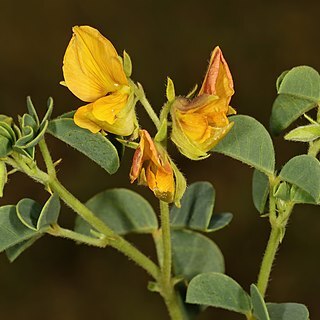Standard elliptic, yellow, ± flushed reddish, medially puberulous outside; wings 0.6–0.7(0.8) times as long as the keel; keel 8–11 mm long, abruptly rounded in lower half, with a practically straight beak, lanate-pubescent along upper margin.
Leaves 3-foliolate; leaflets 8–20 × 8–18 mm, obovate to subcircular, rounded to emarginate at apex, glabrous to thinly pilose above, pilose beneath; petioles shorter to longer than leaflets; stipules 2–5 mm long, subulate or linear.
Racemes laxly 1–3(4)-flowered, with peduncle much longer than the rhachis; bracts 2–4 mm long, linear-lanceolate; bracteoles curved-ascending from upper part of pedicel, similar to bract.
Spreading or semidecumbent perennial, with a number of densely subappressed pubescent to patently pilose stems to 15–50 cm long.
Calyx 7–9 mm long, thinly pilose; lobes attenuately lanceolate-triangular, 4–5 times as long as the tube.
Pod 2.4–3.6 cm long, subcylindrical, practically sessile, somewhat pointed, pilose.
Seeds 3 mm long, oblique-cordiform, rugulose, pale yellow to brown.

